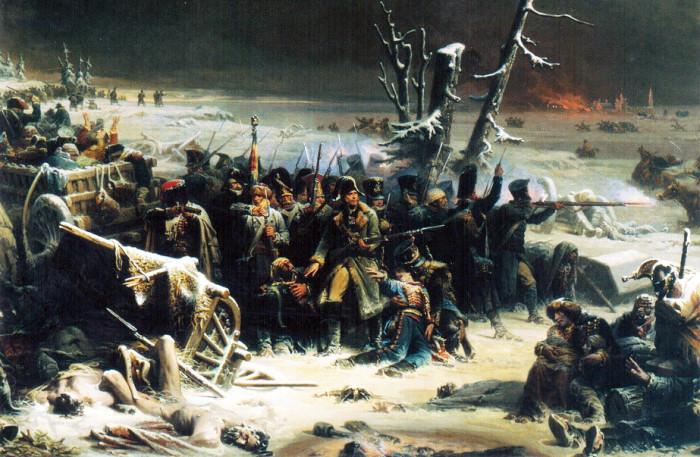
“Besides their nefarious pilfering skills, the 40 Thieves embodied a new breed of jungle fighter within the Corps itself.”
By Joseph Tachovsky
SECOND WORLD WAR Marines were notorious thieves – mostly out of necessity.
As the poorest equipped branch of the armed services, the Marines landed on Guadalcanal for their first battle against the Japanese army outfitted with leftover World War One gear, weapons and rations.
To improve their odds of survival, Leathernecks found it necessary to augment their supplies by what were called “Marine methods,” more commonly known as thievery.
In order to supplement their often-meagre supplies, Marines famously raided Army and Navy storage depots for clothing, food and other necessities.
The elite of the Sixth Marine Regiment, the Scout-Sniper Platoon excelled at the craft, becoming the bane of existence for the better-supplied army and navy quartermasters. Their light-fingered exploits became legendary in the Corps, earning them the nickname of the “Forty Thieves” from their envious peers.
Besides their nefarious pilfering skills, the 40 Thieves embodied a new breed of jungle fighter within the Corps itself. Only two such platoons were deployed during combat in the Pacific. Modelled after legendary British Commandos, the Thieves were trained to secretly and stealthily operate behind enemy lines, where firing a weapon was often the last resort.
It took a certain type of volunteer to be selected to this elite unit. Frank Tachovsky, the platoon’s lieutenant, specifically looked for men with brig time.

“If a man had spent any office hours for brawling” he explained, “or had a black mark on his record for being in fights, that showed he’d been in trouble and could handle himself. The guy that wins the fight is thrown in the brig. The other guy goes to the infirmary. The guy in the brig is the kind of guy I want.”
He needed men who could think on their feet, something that had been drilled out of them in the Corps, misfits in the regimentation of the armed service.
Countless times during the Battle for Saipan the Thieves employed silent killing techniques while working behind enemy lines, often for days at a time. Scouting enemy locations, fortifications, and mapping them to facilitate the advance of line companies was one of their jobs. Cleaning out by-passed trouble spots, a task considered to be one of the most dangerous jobs in the Corps, fell within their expertise, as well.
Using Unertl-scoped 1903 Springfields, the 40 Thieves employed their sniping skills to discourage Japanese troops from descending Tipo Pale on bicycles.
The platoon’s lieutenant led by example while destroying an enemy tank that threatened his men and the regimental command post with a bazooka, one that was acquired by “Marine methods.” Masters of improvisational warfare, the platoon’s weapon-of-necessity for a tank banzai was the Molotov cocktail.

“Some of the craziest, fiercest, most lovable Marines on Saipan are in the Scout-Sniper platoon under the command of First Lieutenant Frank Tachovsky, 29, of New Brighton, Pennsylvania,” USMC correspondent Vic Kalman wrote for the December 1944 issue of Leatherneck Magazine. “Tachovsky’s Terrors have wreaked havoc in, around, and mostly behind the enemy lines. But all their exploits are not recorded in the annals of the high command. And it is their ‘unofficial’ escapades which are becoming Marine Corps legends. Take the Garapan bike patrol, for instance.”
Kalman referred to the small squad of Thieves who were the first American troops to reconnoiter Saipan’s capital of Garapan.
The city had been levelled, but the Thieves found a few places intact, like a general store where they filled their pockets and packs with fabric and food and drinks. They made an artful exit on pilfered bicycles, amusing other service men patrolling the fallen city.
Following Tachovsky’s death in 2011 at the age of 96, his son Joseph located the surviving members of the Sixth Marine Regiment’s Scout-Sniper Platoon. The seven old Leathernecks provided both perspective to the battle for Saipan and a gripping account of their very personal battles following the war. By the age of 20, these teenage boys had lived a lifetime.
 40 Thieves on Saipan, written by Joseph Tachovsky and Cynthia Kraack, is built on their stories about the Sixth Marine Regiment’s elite Scout-Sniper Platoon.
40 Thieves on Saipan, written by Joseph Tachovsky and Cynthia Kraack, is built on their stories about the Sixth Marine Regiment’s elite Scout-Sniper Platoon.
ABOUT THE AUTHOR: Joseph Tachovsky is the author of 40 Thieves on Saipan: The Elite Marine Scout-Snipers in One of WWII’s Bloodiest Battles. A graduate of the Univerity of Minnesota, his father Frank Tachovsky was the commanding officer of the 40 Thieves of Saipan, who were also known as Tachovsky’s Terrors.










I’ve never heard of the Marines ’40 Thieves’ and I do like reading about WWII. Anyway I’ll be reading more.
My father( Claude Dee Moses) fought in the Pacific, he won 4 Bronze Stars. He did not talk about the war at all. He was a wonderful man.
He died at age 80, I found out about the Bronze Stars at his death. He was my hero. I am 75 .
Bradley Dee Moses
PS
He had 3 brothers Nathan,Clarence,and John, they all joined up in the Army.
All where great men.
Joseph tachovsky. I would have liked to have met and spoken with your father, he very well knew my uncle Alexander Peña, he was a member of the 3rd battalion 6th marine regiment 2nd marine division, Guadalcanal, Tarawa, Saipan and Tinian, He was WIA June 17th on Saipan and soon after was KIA July 30th on Tinian, those Marines were heroes, all of them Heroes, the Greatest Generation of All Time.